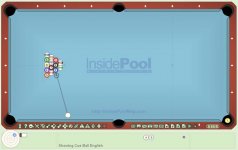I've been reading a lot of posts here in the straight pool forum and really enjoying the comentary - especially strategy and pattern play. However, I've noticed that although there is a lot of talk about running 100 balls, there is almost no talk about safety play. I appreciate advice from the high-run guys about how to run a rack, but it turns out I don't think it would be the right way for a guy like me to work it (if I want to WIN the game at hand). You have to understand, I'm a favorite to do a 5 and miss on a wide open table.
I find myself really having to think much more about taking open balls down first, then playing a nice safe based on available clusters. I have found from experience that shooting the obvious break balls if I don't think I have a good chance to get to them helps a lot, since my opponant will have a lot more trouble linking the next rack together if I do miss.
I play on and off in a handicapped league where against an excellent player, I might have to get only 5 balls/rack. My best games, and the ones in which I end up winning take a LONG time! In these games I rarely set up and play for a break ball, rather I like to set up for a last ball that allows me to get position for an excellent safety on the rack.
Its just too often that I either miss position on my break ball, or just plain miss the breakball shot and sell out. The way I play, my oponent never gets anywhere near their high runs and the game is always close. I bet people hate playing me, but I want to win, so this is what I do.
I still want to get really good and run a lot of balls, so I alternate my practicing between "equal offense" type play, where I try to play the technically correct pattern, and plenty of practice skimming balls and the rack for safeties.
So anyway - please discuss - anyone else in my boat right now?
Jon
I find myself really having to think much more about taking open balls down first, then playing a nice safe based on available clusters. I have found from experience that shooting the obvious break balls if I don't think I have a good chance to get to them helps a lot, since my opponant will have a lot more trouble linking the next rack together if I do miss.
I play on and off in a handicapped league where against an excellent player, I might have to get only 5 balls/rack. My best games, and the ones in which I end up winning take a LONG time! In these games I rarely set up and play for a break ball, rather I like to set up for a last ball that allows me to get position for an excellent safety on the rack.
Its just too often that I either miss position on my break ball, or just plain miss the breakball shot and sell out. The way I play, my oponent never gets anywhere near their high runs and the game is always close. I bet people hate playing me, but I want to win, so this is what I do.
I still want to get really good and run a lot of balls, so I alternate my practicing between "equal offense" type play, where I try to play the technically correct pattern, and plenty of practice skimming balls and the rack for safeties.
So anyway - please discuss - anyone else in my boat right now?
Jon
